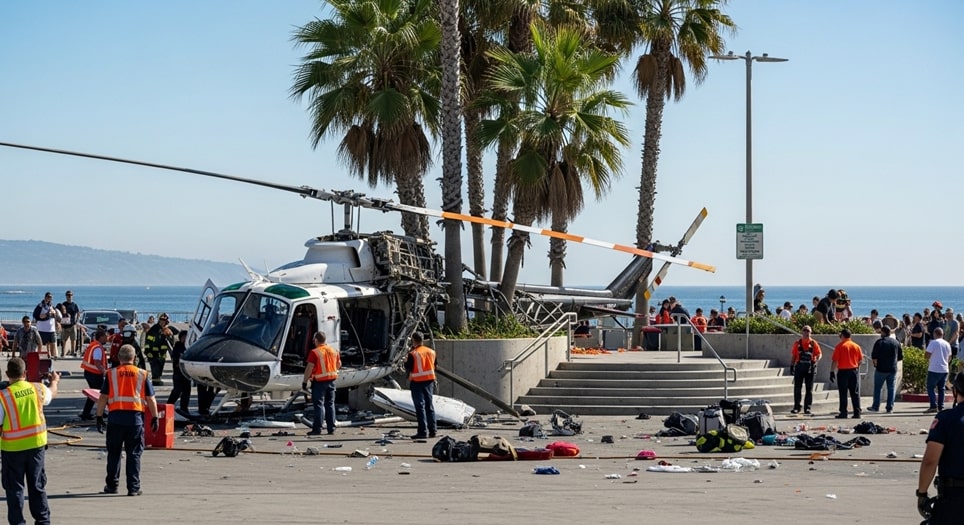
In the heart of Southern California’s bustling coastline, a routine flight turned into a harrowing spectacle on October 11, 2025. A Bell 222 helicopter, en route to a high-profile aviation showcase, suddenly spiraled out of control above a crowded beachfront parking lot in Huntington Beach. The aircraft plummeted into a cluster of palm trees and a pedestrian staircase, scattering debris across Pacific Coast Highway and injuring five people in what could have been a far more tragic outcome. Miraculously, no lives were lost, but the incident has left the community reeling and aviation authorities scrambling for answers.
The crash unfolded just after 2 p.m. local time, mere hours before the kickoff of the annual Cars ‘N Copters on the Coast event, a beloved fundraiser drawing car enthusiasts and aviation fans alike. Eyewitnesses described a serene afternoon shattered by the unnerving whine of rotor blades gone awry. Videos captured by beachgoers quickly went viral, showing the helicopter’s desperate descent and the frantic rush of bystanders to aid the victims. As emergency sirens pierced the salty air, Huntington Beach’s first responders sprang into action, transforming the sun-soaked scene into a coordinated rescue operation.
This event, occurring in one of Orange County’s most popular tourist spots, underscores the precarious balance between recreational flying and public safety. The Waterfront Beach Resort, a Hyatt Regency property overlooking the Pacific, became an unintended epicenter of chaos. Families picnicking, surfers returning from the waves, and event preparations all converged in a moment of collective vulnerability. Yet, in the days following, stories of resilience emerged, from a young boy’s improbable recovery to a pilot’s quick thinking that spared greater harm.
Understanding the full scope requires piecing together the timeline from official reports and firsthand accounts. The helicopter had departed from Redlands Municipal Airport earlier that afternoon, charting a path along the coast for what was billed as an “exclusive helicopter landing party” at the Offshore 9 Rooftop Lounge. Organizers had envisioned a glamorous prelude to the main event, with luxury helicopters mingling among exotic cars. Instead, it became a stark reminder of the skies’ unforgiving nature.
The Crash Unfolds: A Sequence of Seconds
The Bell 222, a twin-engine workhorse from 1980 known for its sleek design and appearances in popular media like the 1980s series Airwolf, was piloted by Eric Nixon, a seasoned aviator with a flair for the dramatic. As it approached the resort at low altitude—estimated below 100 feet—the aircraft emitted a series of sharp, popping sounds that eyewitnesses likened to gunfire. Within moments, the tail rotor appeared to detach, sending the machine into an uncontrollable spin.
Cellphone footage from multiple angles paints a vivid picture: the helicopter banks sharply, its fuselage whipping through the air like a flailing pendulum. It clips the tops of palm fronds before slamming into the concrete stairwell of a pedestrian bridge spanning the highway. The impact shears off the tail section, embedding the main body against the structure while rotor fragments hurl outward, peppering the parking lot and striking bystanders. Debris field analysis later revealed shards scattered up to 50 feet, narrowly missing vehicles and sunbathers.
Weather conditions that day were ideal—clear skies, light southwest winds at 10 knots, and temperatures hovering around 73 degrees Fahrenheit—ruling out environmental turbulence as a primary culprit. Aviation experts reviewing the videos point to a catastrophic mechanical failure, specifically in the tail rotor assembly, which is critical for countering the main rotor’s torque. Without it, the aircraft becomes a spinning projectile, leaving the pilot precious little time to react.
In those critical seconds, Nixon’s actions likely prevented a deadlier toll. Witnesses, including fellow pilots at the scene, praised his decision to steer toward the palms rather than the densely packed lot below. “He sacrificed the machine to save lives,” one observer noted, highlighting the instinct honed from years of high-risk maneuvers. The crash’s low velocity upon impact—estimated at under 20 knots—owed much to this split-second judgment, cushioning the blow for those aboard and below.
Eyewitness Accounts: Terror and Heroism
Beachgoer Kurt Johnston, a local surfer, was steps from the parking lot when the helicopter loomed overhead. “It was like watching a bad dream unfold in slow motion,” he recounted. The popping noises jolted him from his phone, and as the spin began, he dove behind a lifeguard stand, shielding his two young children. Johnston’s video, shared widely on social media, captured the crowd’s initial freeze before erupting into screams and sprints for cover.
Further down the lot, Tim Robinson, a Huntington Beach resident out for a jog, heard the anomaly first. “There was this weird whir, then pops—like fireworks gone wrong,” he said. Positioning himself to film, Robinson inadvertently documented the bystander response: a group of off-duty firefighters, coincidentally at the resort, rushing forward with improvised tools. Their efforts freed the pinned child within minutes, a feat that paramedics later credited with stabilizing his condition.
Jackson Etchert, visiting from Rancho Cucamonga for the event preview, provided dashcam footage from his vehicle. It shows the helicopter dipping erratically toward the bridge, an object—likely the tail rotor—tumbling free. Etchert’s calm narration amid the panic underscores the surreal disconnect: “One second it’s gliding like a pro, the next it’s fighting for its life.” These accounts, corroborated by dozens of similar clips, form the backbone of the ongoing probe.
Immediate Aftermath: From Chaos to Containment
Huntington Beach Fire Department Engine Company 41 arrived within two minutes, declaring a mass casualty incident due to the unknown injury extent. Over 50 personnel from fire, police, and Orange County Sheriff’s Aviation converged, establishing a perimeter amid the throng of spectators. Hydraulic tools extricated the pilot and passenger from the crumpled cockpit, while ground crews triaged the wounded under the shadow of the mangled wreckage.
Pacific Coast Highway shut down between Huntington Street and Beach Boulevard for hours, diverting traffic and stranding event-goers. The pedestrian bridge, a key beach access point, sustained structural damage, closing for repairs that extended into the following week. Cleanup crews removed the bulk of the fuselage on Monday, October 13, but fragments lingered as investigators combed the site for clues.
By evening, all five victims were en route to area hospitals—Hoag Hospital Newport Beach and UCI Medical Center—under stable conditions. The swift response, lauded by Police Chief Alon Brandeis, prevented secondary injuries from the gathering crowd. “The public’s composure was remarkable,” Brandeis stated, noting no reports of stampedes or looting in the unsecured zones.
The Human Toll: Profiles of the Injured
Behind the statistics lie personal narratives of endurance and community solidarity. The five hospitalized represented a cross-section of the beach’s diverse visitors: aviation professionals, a thrill-seeking pilot, and innocent bystanders caught in the wrong place at the wrong time. Their stories, pieced from family updates and hospital releases, reveal the crash’s ripple effects far beyond the physical.
Recovery trajectories vary, but all underscore the fragility of such incidents. Medical teams reported no life-threatening wounds by Sunday, yet the psychological scars— from the terror of entrapment to the guilt of survival—demand longer healing. Fundraising efforts surged online, channeling support into tangible aid for therapies and lost wages.
Pilot Eric Nixon: A Daredevil’s Reckoning
Eric Nixon, 52, from Mentone, California, emerged as the crash’s central figure—not just as the pilot, but as its owner and a social media sensation. With over 50,000 Instagram followers under Nixon Helicopters, he showcased low-level feats that blurred the line between artistry and recklessness: skimming building facades, hugging coastal cliffs, and weaving through urban canyons. His Bell 222, a customized nod to Airwolf, symbolized this passion, upgraded with modern avionics yet retaining its vintage allure.
In the crash, Nixon sustained broken ribs, a crushed vertebra, and extensive bruising, per updates from his father-in-law, Jerry Miller. Hospitalized at UCI Medical Center, he underwent surgery to stabilize his spine and began physical therapy by week’s end. Friends described him as “one of the kindest humans,” a philanthropist who ferried helicopters to charity galas and car shows. His post-crash message on Instagram read simply: “We’re safe, but healing takes time. Grateful for the angels who pulled us out.”
Nixon’s commercial pilot license boasts over 2,000 hours, including instrument ratings and Bell-specific endorsements. Yet, his stunt-heavy portfolio has drawn scrutiny, with some questioning if fatigue or overconfidence played roles. As he mends, Nixon has vowed to advocate for better maintenance protocols, turning personal ordeal into broader advocacy.
The Unnamed Passenger: Silent Partner in Peril
Details on the passenger remain sparse, respecting privacy amid the media glare. Identified only as a colleague assisting with the event demo, the individual suffered minor cuts and a concussion from the impact. Discharged within 48 hours from Hoag Hospital, they issued a brief statement through organizers: “It was a blur, but Eric’s calm kept us grounded—literally.”
This anonymity highlights ethical reporting in aviation mishaps, where crew dynamics often stay confidential pending investigations. Sources close to the pair suggest the passenger was a novice observer, there to film promotional content. Their quick release eased some community fears, allowing focus on the more severe cases.
Oliver Holland: A Boy’s Battle for Recovery
Eleven-year-old Oliver Holland’s story captured national attention, transforming a local tragedy into a symbol of youthful tenacity. Pinned beneath the wreckage after a rotor fragment struck him, Oliver endured a collapsed lung, intracranial bleed, and multiple fractures. Airlifted to a pediatric trauma center, he underwent emergency surgery on October 11 to relieve brain pressure and repair pulmonary damage.
His sister Madeline’s GoFundMe plea went viral, raising over $110,000 by October 22 from more than 2,500 donors. “Oliver is the smartest, funniest boy I know,” she wrote, urging awareness of aerial risks near public spaces. By October 28, family updates confirmed he had awakened from an induced coma, breathing independently for the first time since the crash—coinciding with his 12th birthday.
Further progress reports as of October 31 described Oliver on a “strong path to recovery,” walking short distances with assistance and resuming light cognitive exercises. Neuropsychologists note potential long-term effects from the bleed, including attention deficits, but his baseline resilience offers hope. The Hollands, locals who frequent the beach, now channel their ordeal into pushing for enhanced zoning buffers around flight paths.
Other Ground Victims: Unsung Survivors
Two adults rounded out the ground injuries, their experiences less publicized but no less profound. A father-son duo, pelted by lightweight debris while unpacking beach gear, escaped with lacerations and sprains. Treated at Hoag, the father, a 45-year-old engineer, required stitches for a forehead gash but returned home the same evening, shielding his 8-year-old son in the chaos.
The third, an elderly woman walking her dog near the staircase, sustained a clipped shoulder from a blade shard—deep bruising but no arterial damage. Her quick thinking in ducking behind a palm likely saved her from worse. Released after observation, she joined community vigils, her story amplifying calls for stricter event permitting.
Aviation Under Scrutiny: The Helicopter and Its Legacy
The Bell 222 at the crash’s heart is no stranger to headlines. Introduced in the late 1970s as a light utility transport, it seats up to 10 and cruises at 172 mph, prized for executive shuttles and medevac roles. Nixon’s model, with 1,845 airframe hours and recent July 2025 inspections, bore supplemental upgrades like Garmin navigation—yet its age raised flags among experts.
Maintenance logs, now under federal review, show compliance with airworthiness directives, but the tail rotor’s gearbox—a known vulnerability in aging rotors—emerges as a focal point. Since 2010, the type has logged 12 loss-of-tail-rotor events, per safety databases, often tied to drive shaft fractures or metallurgical fatigue. This incident fits a pattern, prompting whispers of a fleet-wide advisory.
Response and Probe: Layers of Accountability
From the ground up, the response exemplified interagency precision. Huntington Beach’s declaration of a mass casualty incident triggered protocols honed from prior coastal emergencies, mobilizing resources without overwhelming the narrow site. Sheriff’s helicopters provided aerial overwatch, guiding ground teams through the debris maze.
Emergency Services: A Model of Speed
Fire Chief Scott Haberle praised the two-minute arrival, crediting pre-positioned units for the event preview. Paramedics triaged on-site, prioritizing the entrapped child and cockpit occupants. Over 20 ambulances staged nearby, ensuring seamless transport amid snarled traffic.
The operation’s success hinged on bystander integration: civilians formed human chains to clear paths, while off-duty medics applied tourniquets preemptively. This hybrid effort, blending professional rigor with public goodwill, minimized shock and blood loss.
NTSB and FAA: Unraveling the Failure
The National Transportation Safety Board dispatched a go-team from Washington within hours, securing the wreckage for metallurgical analysis. Preliminary findings, due within 30 days, will dissect the tail rotor’s failure mode—whether shear pin snap, bird ingestion, or undetected wear. FAA logs confirm the aircraft’s currency, but supplemental type certificates for Nixon’s mods warrant scrutiny.
Investigators will model the descent using flight data recorders (if equipped) and witness telemetry. Pilot factors, including Nixon’s 2,000-plus hours and recent flight logs, face review for fatigue or procedural lapses. Environmental scans, including radar from John Wayne Airport, rule out air traffic conflicts.
Broader recommendations may target Part 91 private ops, advocating real-time health monitoring for rotors over 40 years. Budget strains from ongoing federal debates have slowed resource allocation, but the board prioritizes this high-visibility case.
Cars ‘N Copters: Resilience Amid the Rubble
The crash cast a pall over the fifth annual Cars ‘N Copters, yet organizers pressed forward with Sunday’s main draw. Hundreds gathered for hypercar parades, military flyovers, and static displays, incorporating a moment of silence for the injured. Coordinator Sarah Kline emphasized enhanced briefings: “Safety is our north star; this tragedy sharpens our focus.”
Proceeds, earmarked for the Huntington Beach Police and Community Foundation, topped $150,000—buoyed by sympathy donations. Low-altitude demos were curtailed, with notams expanding no-fly buffers. Attendees, undeterred, hailed the event’s pivot as a testament to Surf City’s spirit.
The landing party, ironically at the crash site lounge, relocated indoors post-incident, hosting subdued toasts to the victims. This adaptation preserved the fundraiser’s mission while honoring the day’s dark turn.
Safety Echoes: Lessons from the Skies
The Huntington Beach incident slots into a sobering trend: the NTSB tallies over 150 rotorcraft accidents yearly nationwide, with 15 percent in the West Coast corridor. Low-level ops near populated zones amplify risks, as seen in recent LA tour chopper clips and San Diego medevac skids. Experts urge regulatory tweaks to bridge recreational flying’s gaps.
To illuminate potential reforms, aviation safety advocates outline key areas for intervention:
- Enhanced Tail Rotor Redundancy: Mandating dual-drive systems on legacy models could avert single-point failures, as simulated in recent FAA trials. This would add weight but save lives, with retrofit costs offset by insurance incentives. Implementation might phase in over five years for operators like Nixon.
- Real-Time Telemetry Mandates: Equipping private helicopters with black-box equivalents transmits failure precursors to ground stations. Pilots receive alerts via apps, buying critical seconds—proven effective in European fleets. U.S. adoption lags due to privacy concerns, but post-crash polls show 70 percent public support.
- Stricter Event Zoning: Requiring 500-foot buffers from crowds at airshows prevents debris propagation, per updated ICAO guidelines. Huntington’s ordinance, at 300 feet, falls short; revisions could include drone surveillance for compliance. Local councils nationwide eye similar hikes after this wake-up call.
- Pilot Fatigue Protocols: Extending duty limits with biometric wearables monitors stress in stunt flyers. Nixon’s schedule, heavy on promo flights, exemplifies the need; integration with logbooks ensures holistic tracking. Airlines already comply, paving the way for general aviation.
- Public Awareness Campaigns: Beachside signage and apps alerting to overhead flights foster proactive dodging. Post-event surveys in Huntington revealed 40 percent unaware of risks; targeted education, via apps like Flightradar24, empowers civilians. Funding from event fees sustains these efforts.
- Metallurgical Advancements: Accelerating fatigue-testing for airframes over 40 years identifies cracks preemptively. The Bell 222’s history demands this; non-destructive scans, now affordable, could become annual requirements. Collaboration with manufacturers streamlines approvals.
- Insurance and Liability Reforms: Boosting minimum coverage to $10 million for coastal ops deters shortcuts. Victims like Oliver benefit from streamlined claims; current caps often leave gaps, as seen in prior suits. State legislatures consider tying renewals to safety audits.
These measures, if enacted, could halve incident rates within a decade, blending technology with policy. Stakeholders from the Experimental Aircraft Association to coastal mayors convene forums, using Huntington as a case study.
Community Healing: From Hashtags to Heartfelt Aid
Huntington Beach’s response embodied its “Surf City” ethos—laid-back yet fiercely supportive. The #HBStrong campaign trended locally, amassing $25,000 in victim funds via Ruby’s Diner drives and beach yoga fundraisers. Schools wove aviation safety into curricula, with mock drills for low-flying alerts.
Vigils at the resort drew hundreds, blending prayers with pilot testimonials. Nixon’s recovery updates, shared via verified channels, inspired workouts mimicking his rehab. Oliver’s family hosted thank-you picnics, crediting donors for milestone therapies like hydrotherapy pools.
Businesses along PCH offered responder perks—free surf lessons, meal vouchers—fostering unity. Mental health outreaches addressed PTSD spikes, with free sessions at community centers. This grassroots momentum sustains beyond headlines, fortifying the coastal fabric.
Conclusion: Skies Cleared, Lessons Lingering
The October 11 helicopter crash in Huntington Beach, while averted from catastrophe, etched indelible lessons into the sand. From Eric Nixon’s daring deflection to Oliver Holland’s defiant recovery, the event showcased human fortitude amid mechanical frailty. First responders’ precision and the community’s embrace turned potential despair into collective resolve.
As the NTSB’s probe deepens, expecting a full report by mid-2026, calls for systemic safeguards grow louder. Enhanced redundancies, zoning rigor, and awareness could safeguard future flights, honoring the five who endured. In Surf City’s enduring spirit, this close call becomes a catalyst—not a scar—propelling safer horizons for all who chase the thrill of the air or the call of the waves.






